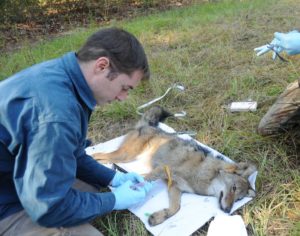SREL seeks link between coyote, fox numbers at SRS
Thomas Gardiner
Aiken Standard
Dec. 16, 2016

Dr. Jim Beasley draws blood from a sedated coyote to help study disease and parasite transmission among candid, or canine animals at Savannah River Site.
In the growing light of early morning, bottles, collars and other gear clink together in a slow moving pickup along bumpy trails through the woods of the Savannah River Site. Dr. Jim Beasley and Ph.D. candidate Sarah Webster look intently at traps along the way, hoping to have caught a coyote or gray fox.
The scientists are part of the Savannah River Ecology Lab, most recognizable in the community by its outreach programs and events such as the annual “Touch an Animal Day.” SREL is under the umbrella of the University of Georgia.
Beasley and Webster are studying the ways coyote and gray fox populations utilize land and food resources, and whether a coyote presence is interfering with gray fox populations.
SRS covers an area of approximately 310 square miles, much of which is forested and unoccupied. Since security measures and fence lines keep general human populations out, the expanse is a great place to study animals and their habitats.
“Before the site, much of the land was agricultural and red fox populations were high,” Beasley said. “Then after the site was built and forestation occurred, gray fox populations moved in as red foxes moved out.”
But gray fox sightings have become scarce, and Beasley wants to find out why.
“Coyote populations didn’t get established here until the late 1980s and the 1990s,” he said.
Beasley said there isn’t much data about the relationship between the species’ interactions since then. To remedy that, Beasley and Webster are collaring the trapped animals and tracking their movements through the forests.
Coyotes have a broader diet than the gray foxes who eat particular diets. If coyotes are competing for gray fox food sources, that could play a role in the changing populations.
Another concern is the gray fox susceptibility to distemper. The collars will tell researchers where there is food source overlap and how easily the disease can be transmitted between populations.
The team uses specially-modified foot traps that don’t injure the animals. Once they find an animal in the trap, they use a catch pole to get positive control so there is no injury because of a frightened response. Then, they inject a mixture of sedatives to put the animal to sleep for collaring.
“Typically the animals are docile and calm when we got to them,” Webster said, adding animals initially struggle and realize they cannot escape the trap, most just lie down and wait.
Once the researchers arrive, they are typically calm, understanding that they can’t go anywhere. Webster also said the researchers don’t approach in a way that gives the message that an animal is in danger.
“We don’t use darts because the needle is a much larger gauge,” she said. “It can also penetrate and cause unnecessary pain and injury, for example, if the dart hit a bone.”
“We are trying to build a bigger picture so we can get a look at the story and understand what’s happening to the animals out here,” Beasley said. “It’s not something you can just understand from a snapshot, so we are creating something we can understand over time.”
